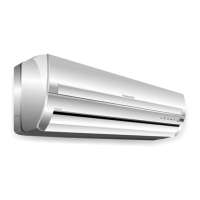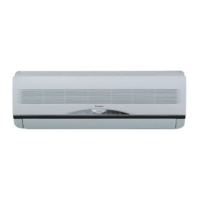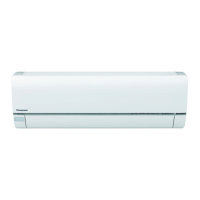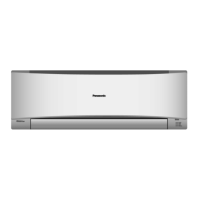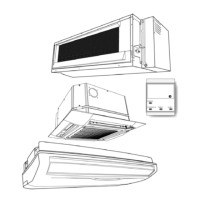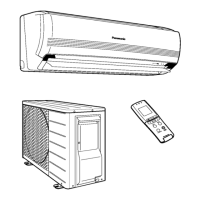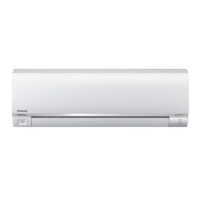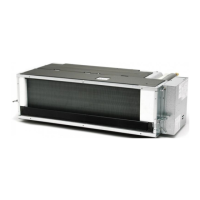Symbol Diagnosis Diagnosis method
H30 Outdoor discharge
pipe temp. sensor
CU-2E:
This trouble display appears when a temperature of under approximately -16 °C or above approximately 200
°C has been detected by the outlet temperature sensor for 2 to 5 seconds.
CU-3E/4E:
Disconnected discharge sensor
·
When the condensation temperature is higher than the discharge temperature + (plus) 6 °C, a sensor
disconnection is detected, operation stops, and the trouble display appears (the timer lamp blinks).
<Diagnosis checkpoint>
1. This trouble display appears when a temperature which is impossibly high or low from a normal standpoint
has been detected.
Check the sensor, and if open-circuiting (more than 500 kΩ) or short-circuiting (less than 0.5 kΩ) is not
found, defective contact of the connector or a defective control P.C. Board is to blame.
H32 Outdoor heat
exchanger temp.
sensor 2
(discharge pipe
temp.)
This trouble display appears when a temperature of under approximately -60 °C or over approximately 110 °C
has been detected continuously for 2 to 5 seconds by the outlet temperature sensor of the heat exchanger.
<Diagnosis checkpoint>
1. This trouble display appears when a temperature which is impossibly high or low from a normal standpoint
has been detected.
Check the sensor, and if open-circuiting (more than 500 kΩ) or short-circuiting (less than 0.5 kΩ) is not
found, defective contact of the connector or a defective control P.C. Board is to blame.
H34 Outdoor heat sink
temp. sensor
This trouble display appears when a temperature of under -43 °C or above 80 °C has been detected by the
outdoor unit radiator fin sensor continuously for 2 seconds.
<Diagnosis checkpoint>
1. This trouble display appears when a temperature which is impossibly high or low from a normal standpoint
has been detected.
Check the sensor, and if open-circuiting (more than 500 kΩ) or short-circuiting (less than 0.5 kΩ) is not
found, defective contact of the connector or a defective control P.C. Board is to blame.
H36 Abnormal gas pipe
temp. sensor
This trouble display appears when a temperature of under approximately -45 °C or above approximately 149
°C has been detected by the outdoor unit gas side pipe temperature sensor continuously for 2 to 5 seconds.
<Diagnosis checkpoint>
1. This trouble display appears when a temperature which is impossibly high or low from a normal standpoint
has been detected.
Check the sensor, and if open-circuiting (more than 500 kΩ) or short-circuiting (less than 0.5 kΩ) is not
found, defective contact of the connector or a defective control P.C. Board is to blame.
H37 Outdoor liquid pipe
temp. sensor
This trouble display appears when a temperature of under -45 °C or above 149 °C has been detected by the
outdoor unit liquid side pipe temperature sensor continuously for 2 seconds.
<Diagnosis checkpoint>
1. This trouble display appears when a temperature which is impossibly high or low from a normal standpoint
has been detected.
Check the sensor, and if open-circuiting (more than 500 kΩ) or short-circuiting (less than 0.5 kΩ) is not
found, defective contact of the connector or a defective control P.C. Board is to blame.
H39 Abnormal indoor
operating unit or
standby units
This display appears in rooms other than one in which indoor freezing trouble has occurred when the pipes
have been connected incorrectly, when an outdoor expansion valve is defective or when an expansion valve
connector has become disconnected.
H41 Abnormal wiring or
piping connection
CU-2E only
This display appears when this kind of trouble is detected 3 minutes after a forced cooling operation was
conducted for one room during the initial operation after the power was turned on. It appears when:
·
The indoor unit pipe temperature in a room without the capacity supply available at an outside air
temperature above 5 °C has dropped by more than 20 °C to 5 °C or lower 3 minutes after the compressor
started up.
·
The outdoor unit gas pipe temperature in a room without the capacity supply available has dropped by
more than 5 °C to 5 °C or lower 3 minutes after the compressor started up.
H97 Outdoor fan motor
mechanism lock
CU-2E:
When trouble, which is defined as a state in which the fan motor speed is not synchronized with the control
signal has been detected on 5 successive occasions, has occurred for the third time in a 60-minute period and
twice during a 30-minute period, the trouble display appears, and operation stops.
CU-3E/4E:
When the fan motor speed detected when its maximum output is demanded is below 30 rpm continuously for
15 seconds, the fan motor stops for 3 minutes and then restarted.
When this happens on 16 occasions (the trouble display is cleared when the value is normal for 5 minutes),
the H97 diagnostic symbol is stored in the memory, and the fan motor stops.
<Diagnosis checkpoint>
1. Check the nature of the fan lockup trouble.
2. Check for disconnections of the fan motor connectors and for defects in contact, in the fan motor and in
the control P.C. Board.
H98 Indoor high pressure
protection
The restriction on the compressor frequency is started when the temperature of the indoor unit heat exchanger
source is between 50 °C and 52 °C, the compressor stops at a temperature from 62 °C to 65 °C, it is restarted
3 minutes later at below 62 °C to 65 °C, and the restriction on the compressor frequency is released at a
temperature between 48 °C and 50 °C. (No trouble display appears.)
<Diagnosis checkpoint>
1. Check the indoor unit heat exchanger temperature sensor (check for changes in its characteristics and
check its resistance): Symptoms include no hot start when operation is started, a failure of the thermostat
to turn on (no outdoor unit operation). And frequent repetition of stopping and startup.
2. Check also for short circuits indoors and clogging of the air filters.
83
CS-ME7CKPG / CS-ME10CKPG / CS-ME12CKPG / CS-ME14CKPG / CS-ME18CKPG / CU-2E15CBPG / CU-2E18CBPG / CU-3E23CBPG / CU-4E27CBPG

